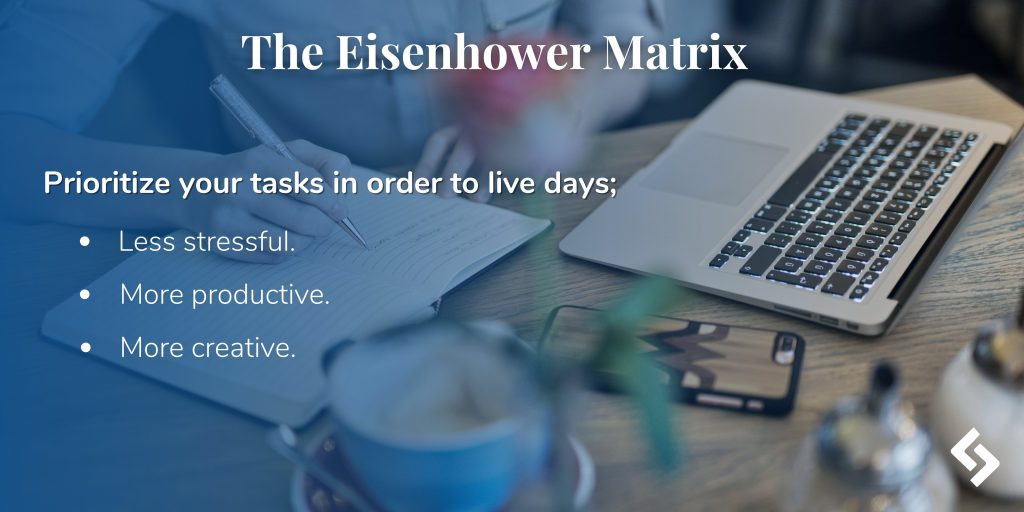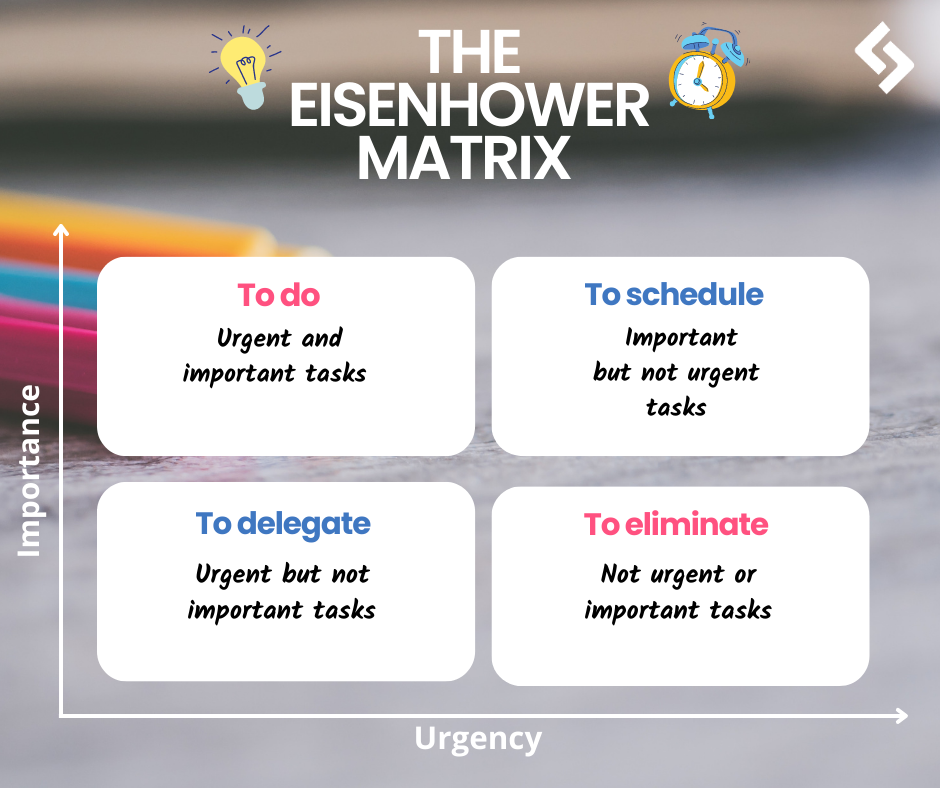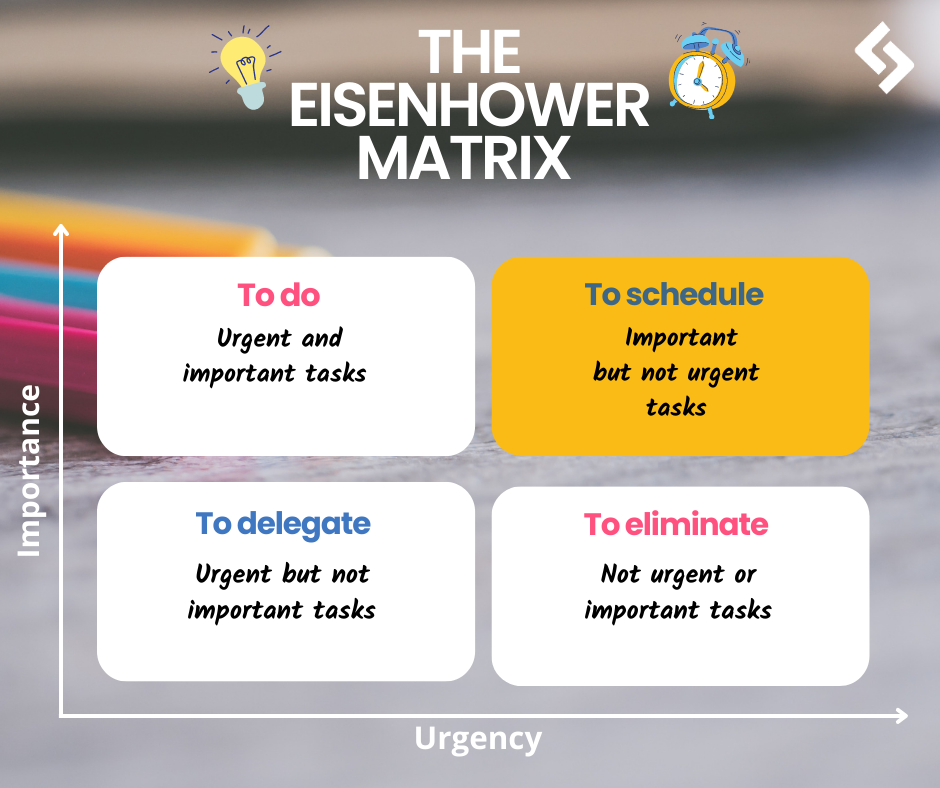We often complain that we don’t know where to start, because our daily lives are sometimes very difficult to manage and we often think that it is due to a lack of time. But it’s more a question of organization and prioritization.
What if I told you that you could do something about it with the famous Eisenhower Matrix!
The Eisenhower matrix will help you prioritize your tasks. In order to organize your days or weeks more easily.
Let’s find out what this matrix is and how to use it to better manage your priorities and your time so that you can better appreciate daily life, even when it remains busy.

I) Origin of the name :

- The Eisenhower Matrix is named after Dwight David Eisenhower, an American military man and statesman who was a member of the Republican Party and the 34th President of the United States for two terms from 1953 to 1961 ;
- During his two terms as President of the United States, he led the construction of the Interstate Highway System,
issued the first major civil rights law since the end of the Civil War, created NASA, ended the Korean War, welcomed Alaska and Hawaii into the Union, and successfully maintained the Cold War with Russia ;
Dwight was a productive man.
Who can define for us exactly the difference between the long and the short term! Especially whenever our business seems to be in crisis, we are almost forced to give our first attention to the urgent present rather than to the important future.
Dwight D. Eisenhower, 1961 speech to the Century Association.
- His countless responsibilities led him to optimize his time and organize himself to be efficient and productive. This led him to create the famous Eisenhower principle, which helps us today to prioritize according to urgency and importance.
- The Eisenhower Matrix was popularized by author Stephen Covey, in his famous book: 7 Habits of Those Who Achieve Everything They Do. Thanks to this book, the Eisenhower Matrix has become a widely used framework for time management and decision making.
II) What is the Eisenhower matrix?
- The Eisenhower Matrix is a graphical time management tool that helps you organize and plan your tasks according to their degree of importance and urgency and thus increase your productivity;
What is important is rarely urgent and what is urgent is rarely important.
Dwight David Eisenhower.
This matrix is presented in the form of a four-quadrant table:

To fully understand the Eisenhower Matrix you must first distinguish between urgency and importance.
III) Distinguishing the urgent from the important :
Urgent tasks:
These are the types of tasks that are done in a hurry and add pressure to our daily lives. They require an immediate reaction and must be dealt with in the shortest possible time.
An untreated emergency can have irreparable consequences in your life.
Example: revising for an exam that you have completely forgotten.
Important tasks:
Important tasks are those that allow us to progress towards our long-term professional or personal goals. They are not time sensitive and therefore require planning and thoughtful action.
- Focusing on these tasks puts you in a reactive state of mind, which can make you calm and open to new ideas. However, they can become urgent if you put them off for a long time.
Example: Plan a training program to be healthier.
- The more time you allocate to what is important, the less urgency there is in your life.
The distinction between urgent and important is therefore clear and yet we often tend to confuse the two terms.
IV) How do I know what is urgent and what is important to me?
Creating a to-do list on your calendar is the best way to determine which activities are urgent and which are important to you.
- Start by thinking about your life goals and the steps you need to take (education, career advancement, money, experience, providing for your family…) ;
- Then list all your professional and personal tasks and goals on a to-do list;
- Once listed, assign a degree of urgency and importance to all your tasks by asking yourself “Is this an urgent or non-urgent task? Then “Is this an important or non-important task?
V) How to classify your tasks in the Eisenhower matrix?
After defining the difference between your urgent and important tasks. You can start to prioritize them in the four quadrants of the Eisenhower matrix.
Quadrant 1: Urgent and Important (Must be addressed first):
These are the tasks that contribute to the achievement of your goals but have a very strict time limit. They therefore require your immediate attention and must be treated as a priority,

- These tasks are often the result of a bad planning,
Example : Imagine that you are working today on a project that was assigned to you a month ago and that the last deadline is tomorrow. This task is important and urgent and requires you to act quickly!
On the other hand, if you had started working on it when you were given the job, it would be important but not urgent.
- Spending a lot of time on tasks in Quadrant (1) can lead to increased stress, mental and physical exhaustion and the feeling that your days are getting out of control. So it is recommended not to put off your tasks until tomorrow, otherwise you risk falling into the trap of urgency.
Quadrant 2: Important but not Urgent (To be planned):
This quadrant contains the tasks on which we should normally invest the most time. Because these are the ones that contribute to our personal growth, development and long-term success.

- The advantage is that they are not limited in time, but you have to plan them well because we tend to focus on what is urgent and put off our important goals.
- This is the quadrant where you focus on your goals and personal growth and not on the problems.
- It is preferable to be well organized so that these important tasks are not urgent and thus avoid being constantly under pressure.
Examples:
- Long and short term project planning.
- Exercise to feel good in your body and in your mind.
- Learn a new skill
Quadrant 3: Urgent but not Important (To be delegated):
These are the disruptive tasks that require immediate attention but do not contribute to our long-term goals.

- Focusing on these tasks will make you feel out of control of your daily life.
Examples:
- Colleagues who come and ask you for something at the last minute;
- Replying to certain emails or messages on social networks;
- Tasks that are important to others, but are not important to you and the progress of your work;
- Household chores;
- If you want to get rid of these tasks, don’t hesitate to delegate them as much as possible. This will allow you to lighten your workload and reduce your stress.
- In case you can’t delegate them; plan them, but always try to prioritize the 1st and 2nd Quadrant tasks.
Quadrant 4: Neither Urgent nor Important (To be postponed or eliminated)
This last quadrant usually contains unnecessary distractions that waste a lot of your time and do not contribute to the achievement of your goals.

- The best solution is to eliminate them completely from your priorities or postpone them to a more convenient time to accomplish them.
Examples :
- Check the notifications on your smartphone (they often interrupt your work);
- Read a book that was recommended to you;
- Watching a Netflix series;
- Shopping;
NB: some of the elements of this quadrant remain moments of leisure that you must allow yourself to recharge your batteries and remain efficient in your work and thus avoid burn-out.
So it’s important to give yourself those little moments of pleasure from time to time without letting them distract you from your important objectives.
In conclusion:
In our busy daily lives, every minute is now counted.
It is therefore better to become a master in the art of time management, if you do not want to lose control of your life. This can be done by using the Eisenhower matrix, which will undoubtedly help you find the perfect organization for your daily life.
 SARAH BRAHMI
SARAH BRAHMI
Similar articles:
Does the ratio 20/80 appeal to you? It is PARETO who is at its origin
Get rich out of nothing ! It’s possible